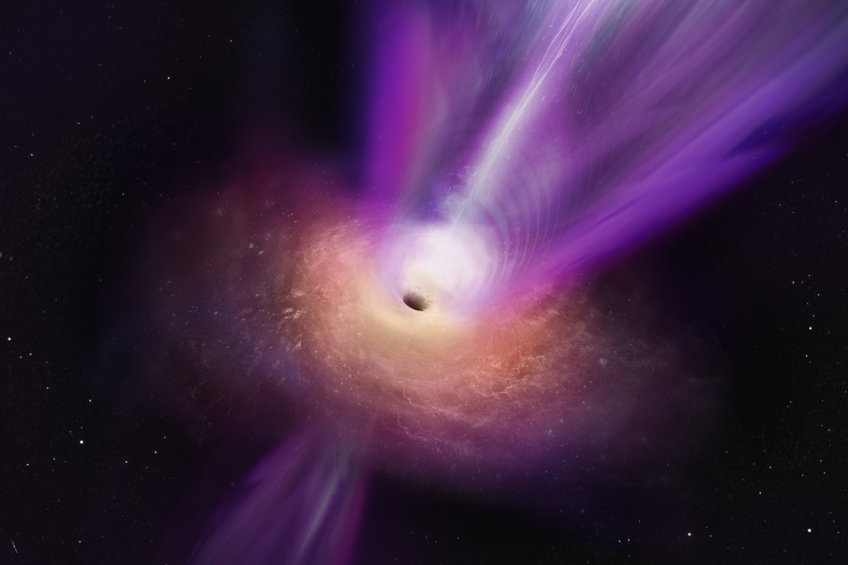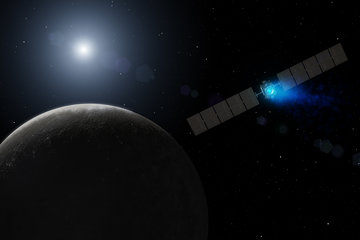The digestive system of the mass monster M87
New observations reveal how a powerful jet forms around a black hole
A few years ago, the image of an orange glowing donut caused a sensation. For the first time, researchers have captured an image of the immediate vicinity of a supermassive black hole at the centre of the galaxy M87. This galaxy is known for a jet that accelerates matter far out of the galaxy, driven by the central black hole. How exactly the jet is anchored in the vicinity of the black hole and how the matter streams into the jet is not yet fully understood. Astronomers, with the participation of the Max Planck Institute for Radio Astronomy, are now providing new answers. With a network of radio telescopes almost as large as the Earth itself, they are using the example of M87 to make the matter flows in the extreme centre of a galaxy visible for the first time.

It is assumed that the enormous brightness and activity at the centre of a galaxy like M87 is due to matter from the surrounding area falling into the black hole at the centre of the galaxy. However, some of the matter is also channelled out of this region via a jet. In the case of the galaxy M87, there have already been separate images of the innermost disc of matter around the central black hole and the jet. However, it was previously unclear how the jet, which remains collimated all the way to the edges of the galaxy, forms in the vicinity of the black hole. The image that was now obtained establishes the connection for the first time. "We see how the jet emerges from the ring around the black hole and gain new insights into the physical processes that give rise to the jet," says Thomas Krichbaum from the Max Planck Institute for Radio Astronomy.

A giant telescope does detailed work
The international research team obtained the image by observing the radio light at a wavelength of 3,5 millimetres. This allows an almost unobscured view onto the radio-bright matter streams that surround the central black hole, and that fuel the jet. Seen from Earth, this inner region appears only about as large as a concert spotlight on the Moon, corresponding to an angular diameter of 64 microarcseconds. At a distance of the galaxy of about 55 million light years, this corresponds to a few times the diameter of our solar system. In order to resolve these structures, which are tiny when seen from Earth, the researchers use an array of many radio telescopes. The larger the network and the further apart the individual telescopes are, the smaller the structures that can be imaged. The wavelength that the radio receivers are tuned into also define the image. The shorter the wavelength, the finer the structures that can be imaged. The central component of the network is the Global Millimetre VLBI Array (GMVA), which spans Europe and North and South America with more than a dozen individual telescopes. To improve the imaging quality, the team also added the Atacama Large Millimetre/Submillimetre Array (Alma) and the Greenland Telescope.

Only through the special arrangement of the telescopes and the choice of the wavelength of 3,5 millimetres were the scientists able to image the galaxy's central engine and how matter flows into the black hole and is accelerated outwards in a jet. They observed the galaxy's core back in April 2018 and took years to interpret the data and reconstruct the image. "The spectacular image of the jet and ring in M87 is an important milestone and crowns years of collaborative effort," says Eduardo Ros, a scientist at the Max Planck Institute for Radio Astronomy. The image of the nucleus of M87, which astronomers had succeeded in obtaining a few years earlier with a different telescope configuration, the Event Horizon Telescope at a wavelength of 1,3 millimetres, is characterised by an even stronger zoom factor. It mainly shows matter in a comparatively narrow ring in the immediate vicinity of the black hole. This donut-like image marked the black hole itself for the first time.
Tracing the boundaries of physics
For J. Anton Zensus, Director at the Max Planck Institute for Radio Astronomy, these successes show that the years of development and continuous expansion of the technology of these global radio telescope networks have paid off. But the limits of this high-resolution observation technique have not yet been reached. New, even more sensitive radio receivers of the GMVA telescope should enable the astronomers to make further detailed measurements. In addition to the light intensity, which has been imaged here, other properties of the radio light can also be extracted. The polarisation, for example, mimics the structure and strength of the underlying magnetic field that surrounds the black hole and shapes the jet. Matter that is visible via its radio emission in the presented image, moves along these invisible magnetic field lines. These and other measurement techniques make it possible to study the physical processes in the immediate vicinity of a black hole, billion times heavier than the sun, which embodies the limits of physics.
NJ/TB














